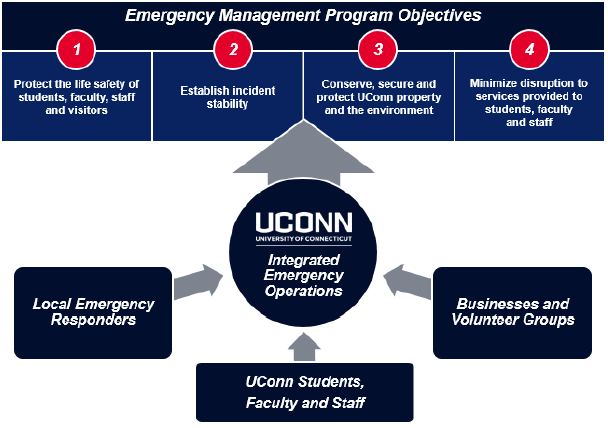
THE PLAN
UCONN EMERGENCY OPERATIONS PLAN
The Office of Emergency Management has developed and maintains UConn’s Emergency Operations Plan (EOP) with involvement from the UConn community. The EOP is an all-hazards plan that details the procedures for planning, response, recovery and mitigation of hazards and threats to the University of Connecticut at all campus locations. Essential University of Connecticut personnel review the document to become familiar with its guidelines prior to an incident or event. The EOP is reviewed and tested annually to ensure effectiveness.
The Emergency Operations Plan meets current State of Connecticut and Federal statutory requirements. The Emergency Operations Plan contains:
- key concepts and activities of planning, response and recovery;
- a common concept of coordination, both internally and in partnership with external agencies;
- expectations and processes for gathering and sharing information, as well as decision-making;
- clear roles and responsibilities for key divisions, departments and offices; and
- provides resource management, finance and administrative guidelines for incident management.
The Emergency Operations Plan divides into three major parts:
- Basic Plan: Presents an enterprise framework for the emergency management program for UConn across all campuses (including UConn Health) and Education Abroad programs. Thirteen appendices support the Plan, including Presidential authorization for particular practices and leadership oversight, program management, operational guides, as well as a multi-year training program.

- Functional Annexes: Seven major annexes provide detailed considerations for emergency activities that are common across different types of incidents. These annexes contain an overview of UConn’s enterprise-level operations, concepts of operation for each campus and roles and responsibilities for each division, department or
office that has an identified lead or supporting function. The Functional Annexes are:- External Affairs and Public Information (public information, crisis communication, public education and outreach)
- Agricultural, Natural Resources and Animal Care (animal care, animal disease management, natural resource assessment and response, agriculture, water management, sustainability)
- Public Protection (University Safety emergency communication, life safety programs, security programs, emergency response, protective actions)
- Infrastructure Systems (utility systems support, facilities management and assignment, roadway and access control, information technology systems)
- Human Services Support (campus mass care relocation and feeding services, family reunification and support, donation and volunteer management, host community)
- Public Health and Medical (emergency medical services and mass casualty management, infectious disease response, fatality management, medical countermeasures, health care surge for the University community, University disaster mental health)
- Recovery and Mitigation (damage assessment, debris management, short and long term recovery planning, mitigation planning process)
- A Hazard Specific Annex: This Annex provides detailed considerations on how UConn will respond to a number of different specific hazards with a broad concept of operations containing actionable checklists. The Annex contains approximately thirty identified threats and hazards, including severe weather, active threat/violence/shooter, utility failure, mass casualty, mass fatality, pandemic influenza, significant events, and bomb threat, among others.
The UConn Emergency Operations Plan is stored online. You can view the Base Plan by clicking the link below. Functional and Hazard-Specific Annexes are confidential.
If you have any questions or comments, please contact the Office of Emergency Management at oem@uconn.edu or 860-486-5174.
Developing an Integrated Emergency Management Program